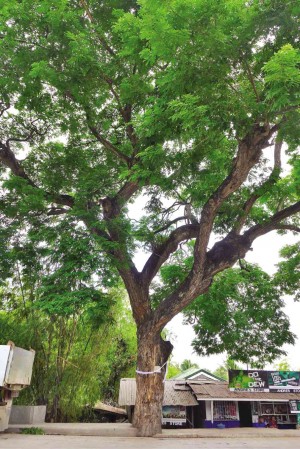
A SLIDE presentation by tree expert Dr. Roger Guzman shows a tree in Naga City cemented onto the pavement. CONTRIBUTED PHOTO
CEBU CITY—The 84 trees in two cities and one town in southern Cebu province earlier diagnosed by the environment agency as “diseased and rotting” can still be saved, according to tree expert Dr. Roger Guzman, retired forester and now executive director of the Philippine Federation for Environmental Concerns.
Four of the 84 trees were “heavily injured,” Guzman said. The rest were suffering from “physical injuries,” he added during the presentation of his three-day assessment on the trees along the national road in San Fernando town and Naga and Carcar cities.
The presentation at the Capitol on Friday was attended by officials of the Department of Environment and Natural Resources (DENR) in Central Visayas, the provincial government and civil society groups.
Guzman was asked to conduct an assessment on the 84 trees in Carcar, Naga and San Fernando after a DENR forester recommended their cutting because they were diseased and rotting.
Of the 84 trees, 37 were century-old acacia trees. The rest were gmelina, mahogany, tamarind, talisay, antipolo, jackfruit and binunga, among others.
Guzman said he noticed that the bases of several trees were covered in cement from the road improvement, thus obstructing the natural growth of the trees.
Some branches, he added, were not pruned properly, allowing diseases to set in. Nearby residents also threw or burned garbage at the base, making the trees sick.
Guzman recommended that the trees undergo proper pruning and tree surgery, especially those with deep cuts on the trunks, as well as the removal of cement to provide tree bases sufficient space for girth growth.
But the DENR in Central Visayas doesn’t have budget for tree surgery, which costs at least P9,000 for each tree, said its spokesperson, Eddie Llamedo.
He said the cost covered pruning, trimming, surgery preparations and chemicals used to cover the wounds of the trees.
Local governments, he added, were responsible for the care and maintenance of trees on roadsides and public plaza.
Eduardo Inting, DENR Central Visayas technical director for forestry, said conducting tree surgery would only be a waste of money since “the healing rate of the trees could not compensate for the decaying process of the trees.”
Guzman said that while the rotting of the center might be common for old and maturing trees, it did not reduce the strength of the trees.
He added that DENR foresters should supervise the pruning and trimming of decaying branches to prevent accidents. Besides, he said, improper pruning made the trees sick.
Guzman recommended a “comprehensive assessment,” especially on the four century-old acacia trees in Naga and San Fernando that were “heavily injured.”
Two of these were in Barangay Inoburan, Naga, and another was in Barangay Balud, San Fernando.
Cement wrapped around the bases of the two trees in Inoburan while the vines of a nearby balete tree tangled with the acacia tree in Balud.
Guzman said the vines should be removed because these would cause decay in the acacia tree.
Guzman admitted in an interview that his “rapid assessment” on Aug. 13 to 15 was not enough to determine the condition of these trees. It would take at least a week to have a comprehensive assessment, he added.
But Inting said the DENR in Central Visayas conducted two assessments before the agency recommended that the trees be cut.
Inting said DENR foresters inspected 154 trees along the south highway in Naga and spent six months assessing them. These 154 trees were covered by an application for cutting permit from the Department of Public Works and Highways in Central Visayas in 2012 in relation to a road-widening project that covers Naga, San Fernando and Carcar.
Inting also said DENR Regional Director Isabelo Montejo had even directed the Ecosystem Research and Development Sector unit to conduct a separate study on the trees.

